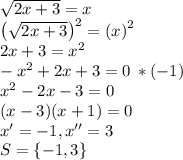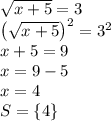
Mathematics, 06.07.2019 03:40 dreannaevans2
Part 1. create two radical equations: one that has an extraneous solution, and one that does not have an extraneous solution. use the equation below as a model. a√x+b+c=d use a constant in place of each variable a, b, c, and d. you can use positive and negative constants in your equation. part 2. show your work in solving the equation. include the work to check your solution and show that your solution is extraneous. part 3. explain why the first equation has an extraneous solution and the second does not.

Answers: 1


Other questions on the subject: Mathematics

Mathematics, 21.06.2019 20:30, kuddlebugsmommy
Martha has a deck of cards. she has lost some of the cards, and now the deck only contains nine spades, eleven diamonds, eight clubs, and twelve hearts. martha predicts that whenever she draws a card from the deck without looking, she will draw a club one-fifth of the time. which activity would best allow martha to test her prediction? a. randomly draw a card from the box and see if it is a club. b. randomly draw a card. then, continue to draw another card until all eight clubs are drawn. c. randomly draw and replace a card 120 times. then, observe how close to 30 times a club is drawn. d. randomly draw and replace a card 100 times. then, observe how close to 20 times a club is drawn.
Answers: 1

Mathematics, 22.06.2019 00:30, kitykay2399
An unknown number x is at most 10. which graph best represents all the values of x? number line graph with closed circle on 10 and shading to the right. number line graph with open circle on 10 and shading to the right. number line graph with open circle on 10 and shading to the left. number line graph with closed circle on 10 and shading to the left.
Answers: 1

Mathematics, 22.06.2019 01:40, savthespice
Manuela solved the equation below. what is the solution to manuela’s equation?
Answers: 2
You know the right answer?
Part 1. create two radical equations: one that has an extraneous solution, and one that does not ha...
Questions in other subjects:


Physics, 18.09.2021 19:30


Mathematics, 18.09.2021 19:30

Mathematics, 18.09.2021 19:30


English, 18.09.2021 19:40

Mathematics, 18.09.2021 19:40


 b)
b) 2) Solving and Checking on section 1 3) Commonly when we square both sides and there's an x on the right side outside the radical equation, an extraneous solution arises.
2) Solving and Checking on section 1 3) Commonly when we square both sides and there's an x on the right side outside the radical equation, an extraneous solution arises.









